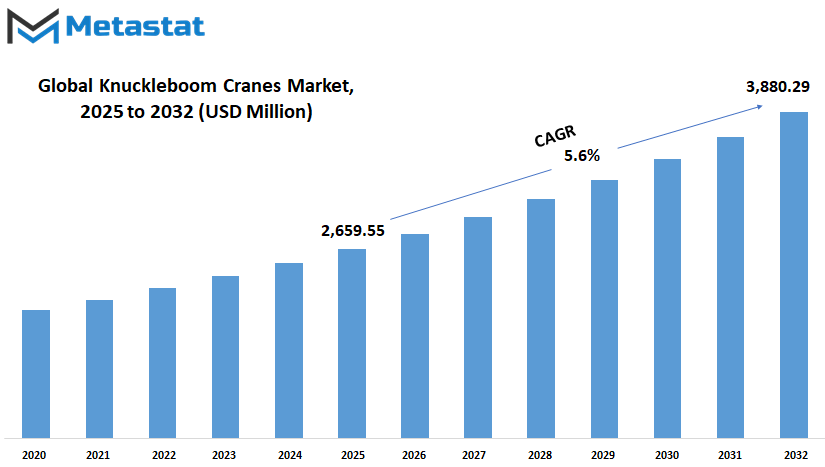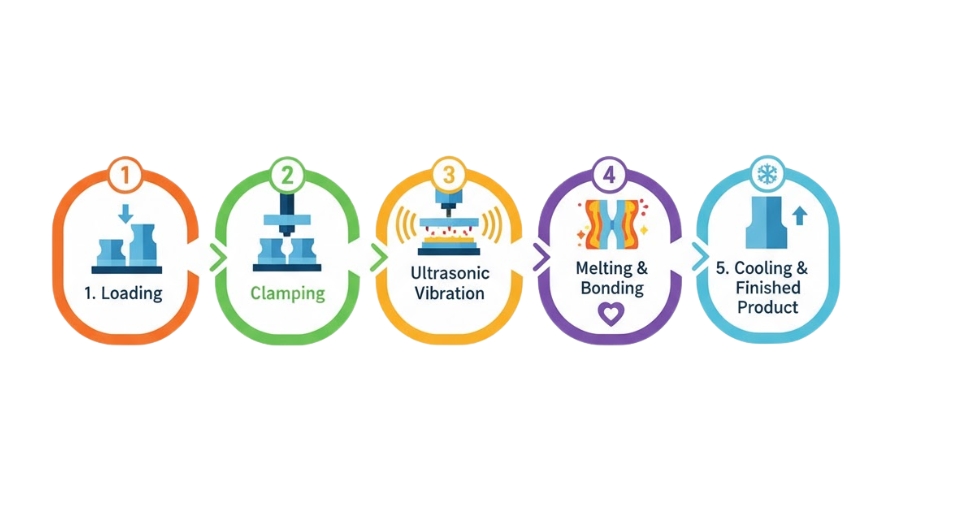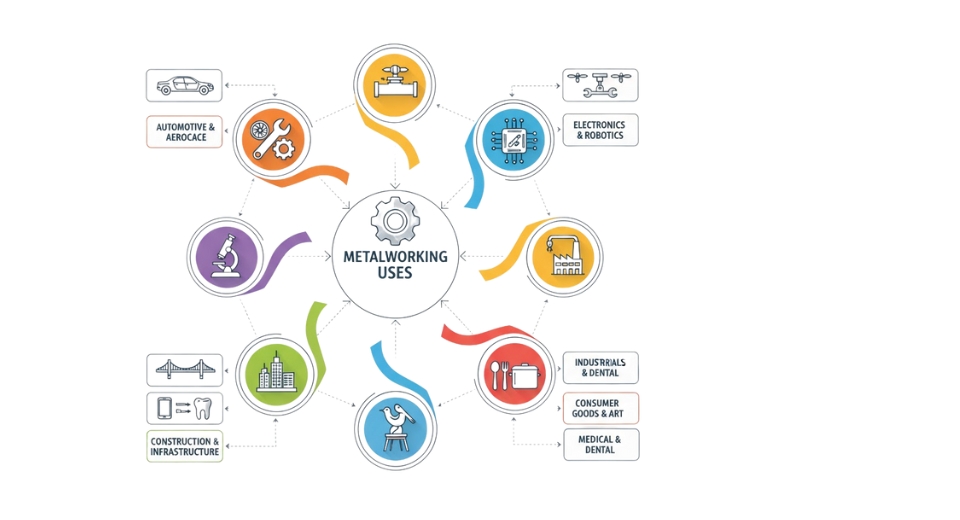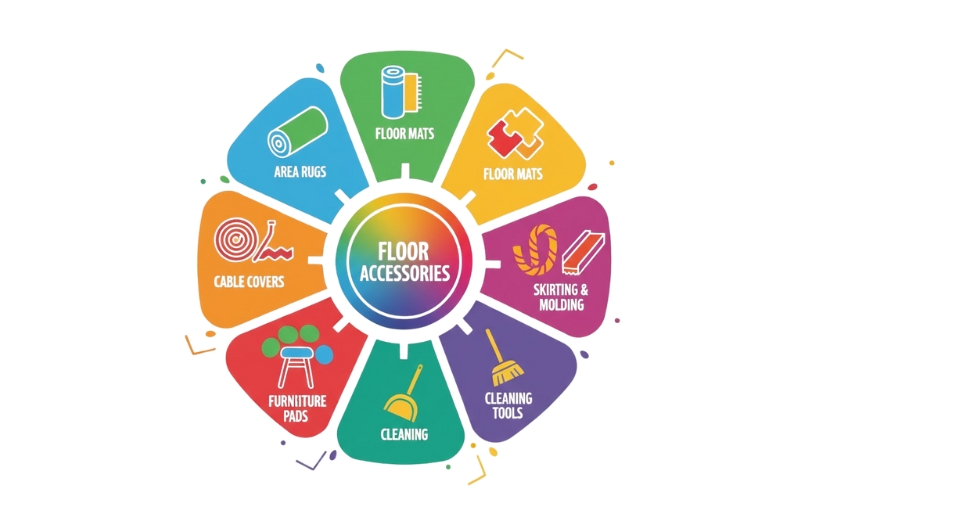MARKET OVERVIEW
The Global Knuckleboom Cranes market is considered an important factor in construction, logistics, marine, and transportation industries by providing versatile lifting solutions to be used in various applications. These cranes are built with an articulated arm that folds at multiple joints, which enhances maneuverability in very constricted areas. In contrast to the ordinary straight-boom cranes, this design improves efficiency in the workplace by enabling precise handling of loads in difficult environments. The ongoing efforts exerted from industry perspectives to develop advanced lifting equipment will continue to play a vital role in the acceptance of knuckleboom cranes.
Hydraulic technology is, in fact, a large part of how these cranes work when lifting heavy loads with the greatest degree of smoothness and control. Global Knuckleboom Cranes are engineering solutions that emphasize a balance between strength and flexibility in that all equipment stands ready to conform to industry-specific loading, lifting, and transportation requirements. Construction is a common place that has constraints making it impossible for conventional cranes to work; the knuckleboom cranes come in to fill this gap perfectly. Their ability to move in and out close to the wall or provide access from behind walls makes them useful for inner city infrastructure projects, industrial maintenance requirements, and offshore.
The versatility of these knuckleboom cranes will always keep them in demand in industries where precision handling is required. The Global Knuckleboom Cranes market is therefore very supportive of industries that require adaptable solutions for transporting and positioning heavy materials with limited space constraints. As manufacturers evolve, the provision of custom design solutions to include project-specific requirements will spur additional developments in design and function.
Marine applications will remain an important segment of this market, as knuckleboom cranes provide safe and secure lifting solutions for shipboard operations, oil rigs, and dockside cargo handling. Their strengths in working in hostile environments with compact storing capabilities render them indispensable to offshore industries. The Global Knuckleboom Cranes market will continue to present solutions to the shipping logistics industry to cater for accurate and safe cargo transfers and maintenance operations.
Manufacturers will be looking to increase capacity, durability, and additional automated features to suit market requirements. The new advanced control systems integrated into knuckleboom are likely to provide more safety and efficiency while reducing manual interference in lifting. Further innovations are expected in the Global Knuckleboom Cranes market as companies research and develop energy-efficient models that meet environmental regulations. An industry shift toward hybrid and electric-powered models will present itself, maintaining performance equilibrium throughout the transition.
Regulatory standards governing load handling equipment will influence design and manufacturing trends to ensure that cranes meet safety and performance benchmarks. Specific needs pertinent to the industry will shape the Global Knuckleboom Cranes market and its manufacturers to produce models in accordance with local and global regulations. Safety remains the main reason for development concerning material choice, structural integrity, and automation.
Moving forward, the Global Knuckleboom Cranes market will certainly aid infrastructure developments, works including maritime logistics, and industrial projects requiring efficient lifting solutions. Industries engaging these cranes keep enhancing safety, precision, and flexibility, thus making these cranes a prime asset in operations demanding high-performance lifting capabilities in constrained spaces. The advancement in technology will further enhance the capabilities of knuckleboom cranes to meet the ever-increasing demand from construction, transport, and offshore industries.
Global Knuckleboom Cranes market is estimated to reach $3,880.29 Million by 2032; growing at a CAGR of 5.6% from 2025 to 2032.

GROWTH FACTORS
With industries looking for more efficient and flexible lifting solutions, the demand for knuckle boom cranes will continue to rise. The advantages of knuckle boom cranes that allow them to operate in restricted space, high load-handling capacity, and ease of use in construction, marina, logistic, and utility works have created a huge demand. The Global Knuckleboom Cranes market would continue to flourish, especially with increased focus on technology improvement, safety, and operational efficiency by manufacturers. With expansion of the industrial base and increase of infrastructure projects, the demand for cranes that can provide better performance and adaptability will keep fueling market growth.
The increasing emphasis on automation and smart control systems is one of the key growth drivers. Companies are investing in advanced hydraulic and electronic control mechanisms for greater precision and ease of use. Improved fuel economy, along with a transition to electric and hybrid models, will have strong say in how the industry shapes up. With the concerted efforts by many companies to reduce emissions and comply with environmental regulations, energy-efficient cranes are bound to see growth in demand. Enhanced safety features, such as real-time monitoring and automated load management, will further streamline operations and reduce the risk to the operators.
Another major factor driving growth is increasing infrastructure development in various regions. Urban development, transportation networks expansion, and renewable energy investments are increasing the need for versatile lifting equipment. Knuckleboom cranes, given their flexible character and compact design, are becoming the hoisting equipment of choice for such construction projects. Their capability to undertake very complex lifting assignments in restricted spaces makes them indispensable in sectors where productivity and precision matter most.
Nevertheless, some constraints are expected to slow the growth of the market. High initial costs and maintenance costs for knuckle boom cranes will limit their adoption among small and mid-sized companies. In addition, any fluctuation in the raw material pricing may elevate manufacturing costs and, in turn, impact the overall market trend. But despite these existing limitations, continuous research and development are supposed to reduce costs and increase product durability, making these knuckle boom cranes more available to a wider section of industries.
New opportunities will arise in the market with future advancements in technology. Artificial intelligence and IoT-based monitoring systems will bridge the gap for the operator to track performance, identify fault in advance, and optimize crane utilization. Remote operation will be a productive solution in risky environments in terms of safety. As industry changes, manufacturers will also work towards cranes providing higher lifting capacities, better fuel efficiency, and improved control systems. Through technology advancement and emerging requirement for innovative cranes, the market for Global Knuckleboom Cranes will keep growing.
MARKET SEGMENTATION
By Type
The increasing demand for knuckleboom cranes is a foregone conclusion as the industry keeps on searching for efficient flexible lifting mechanisms. These cranes are often utilized in rather precision and versatile demanding building and construction jobs, logistics, marine, and other sectors. Unlike traditional cranes, these have an articulated arm, which allows for substantial maneuvering, making them suitable to be used in relatively small areas with a complex job site. Companies have concentrated on developing models such that they achieve superior lifting capacity and, at the same time, leave minimum effect on the ease of operation. The expansion of industries and increased infrastructure development will lead to more advanced lifting appliances, thus pushing the manufacturers toward the development of more innovative solutions.
The global market of Knuckleboom cranes will undergo explosive transformation as technology is getting incorporated into design and functionality. Improving efficiency and safety is being achieved through automation, remote operation, and smart monitoring systems. Manufacturers are spending on lightweight but high-durability materials to improve fuel efficiency and cut costs. This will make the equipment more reliable with a wider range of applications.
The market is segmented basing on different boom ranges, including small, medium, and large. Each of these serves particular requirements from light lift work in warehouses to heavyweight lift in industrial and marine sites. Demand for small boom range cranes will grow as more and more organizations look for small and efficient lifting. The demand for medium boom range cranes will be higher because of their versatility in handling both moderate and heavy loads, thus, making them effective in multiple industries. Large boom range cranes will always play a vital role in heavy-duty lifting requirements in shipyards and mega construction projects.
The competition among manufacturers will always see improvements in design and functionality. Companies will aim to design cranes focused not only on raising productivity but also on life safety and environmental impact. Such models will now be more acceptable to industries looking for green technology because they will be electric or hybrid powered, thus being economical in emissions and operational costs. This digital technology will also provide real-time monitoring systems for operators to track performance, detect any faults early, and improve overall efficiency.
The Global Knuckleboom Cranes Market is changing according to new challenges and the introduction of technology. Innovation, sustainability, and more efficiency will push the industry further toward ensuring equipment for businesses to improve productivity with safety and reliability. Manufacturers that adjust to the flow will stay competitive in the market and provide solutions for today's and tomorrow's industries.
By Application
The Global Knuckleboom Cranes market is said to retain its growth curve as industries continue to look for solutions that are more efficient and flexible for lifting. The cranes' ability to work in confined spaces while at the same time handling heavy loads makes them valuable within industries. Demand for compact, yet powerful, lifting equipment will grow with rising construction activities and more congested cities. Due to the versatility of knuckleboom cranes, they remain the preferred choice for companies requiring precision and reliability in their operations.
Technological advancement, over the next few years, will be a major area of influence on the market. These companies will, therefore, channel their focus toward automation and remote-controlled systems for improving safety and efficiency. Crane designs will integrate smart sensors and artificial intelligence so that operators can monitor weight distribution, stability, and performance in real time. With the added advantages of accident risk reduction and increasing productivity, knuckleboom cranes can now be regarded as a more intelligent investment for industries. With increasing environmental concerns, the manufacturers will also be working toward energy-efficient models with reduced fuel consumption and emissions.
Different industries will continue to drive demand based on their particular requirements. In construction, the cranes will be responsible for lifting material in otherwise crowded job sites that are not acceptable for old-fashioned cranes. The forestry sector will exploit their ability to deliver log systems with low manpower, enhancing productivity. They will be employed by mining companies to transport heavy loads in challenging environments, while transportation will capitalize on these to ease loading and unloading of cargo. New horizons in applications will open as enterprises learn about their versatility and invest in solutions that improve operational capability.
Manufacturers in the Global Knuckleboom Crane industry need to stay one step ahead by innovating for market requirements. Customization is a big consideration, with companies offering specialized versions for different uses. Companies with the ability to customize cranes for specific applications will have a competitive advantage that will allow them to serve industries that require specialized lifting solutions. Automation and digital connectivity will also evolve into standard added values that improve precision and provide uninterrupted operations.
In the coming future, the industry will then turn toward smarter, safer, and greener. Advanced materials, electric-powered systems, and AI-enabled controls will mark a new era of knuckleboom crane use. The businesses investing in R&D will be the vanguards of the market, ensuring that the industries relying on these cranes will have state-of-the-art equipment. With improvement in technology, these cranes will advance in efficiency and safety, thus determining the future of lifting solutions in several sectors.
|
Forecast Period |
2025-2032 |
|
Market Size in 2025 |
$2,659.55 million |
|
Market Size by 2032 |
$3,880.29 Million |
|
Growth Rate from 2025 to 2032 |
5.6% |
|
Base Year |
2024 |
|
Regions Covered |
North America, Europe, Asia-Pacific, South America, Middle East & Africa |
REGIONAL ANALYSIS
Future developments in this sector will be characterized by the introduction of smart features that provide better control and efficiency. In a system wherein activities are automated by sensors, an operator could position loads with maximum precision, thus greatly minimizing the risk of accidents. Remote operation capabilities will also become more suitable, promoting the control of cranes from a distant location. Such innovations will prove to be instrumental in ensuring safety and productivity in the workplace, thereby increasing knuckleboom cranes' value among industries.
The Global Knuckleboom Cranes market will continue to grow around the world. Steady growth will be in North America, where infrastructure projects are still ongoing in the US, Canada, and Mexico. In Europe, the demand should be propelled by investment in the transportation and energy sectors chiefly in the UK, Germany, France, and Italy. In the Asia-Pacific region, comprising India, China, Japan, and South Korea, the demand for efficient lifting equipment stimulated by rapid urbanization and industrialization will greatly influence the market. South America will be more buoyant because of construction and mining activities, particularly in Brazil and Argentina. Finally, the Middle East and Africa will be mostly concerned with strengthening their industrial and logistics sectors, and markets for crane solutions will, hence, arise from GCC countries, Egypt, and South Africa.
As industries continue to push for greater efficiency, companies producing knuckleboom cranes will need to stay ahead by adopting new materials and smart technologies. A likely feature of the designs will be improvements in fuel economy, electric power options, and monitoring systems with real-time information relayed to the operator. This move toward the innovative will greatly enhance performance while lowering environmental impact, thereby creating a sustainable crane.
The rivalry in the market will help spur market innovation and supply companies with an ever-evolving set of equipment, with great quality, durability, and sophisticated technology. The Global Knuckleboom Cranes market will remain an important avenue for industrial advancement that will find a way to adapt for the needs of emerging sectors as it diversifies to embrace modern solutions in the name of improved safety and efficiency.

COMPETITIVE PLAYERS
Knuckleboom cranes will see a continued demand rise as industries search for efficient and agile lifting solutions within limited spaces that are greatly maneuverable. According to advancements in the industry, manufacturers are putting their effort into achieving heavier, more precise, and durable cranes yet easy to be operated by an operator. Significant changes are bound to be experienced by the global knuckleboom cranes market with the emerging designs incorporating automation and smart systems features in equipment. Additional paybacks to operators could be attained from features like remote-control load monitoring and safety sensors to avoid accidents as well as effectively carrying out operations.
With growing demands for the development of lifting equipment, construction activities will extend beyond the sectors of logistics into marine activities and forestry. Manufacturers thus seek to engineer new cranes capable of taking heavier loads with stability and control, and the strength of these materials will, to a large extent, promote durability without heavy mating. This has to be coupled with development systems that will be managing with digital platforms in terms of tracking performance and maintenance scheduling and maximizing utilization. This overall transformation of machinery into intelligence will encourage competitors to invest in R&D for retaining or acquiring a good position in the field.
The Global Knuckleboom Cranes market will experience fierce competitive activity because of leading companies bringing innovative designs to the market in answer to the industry's needs. Well-known companies producing high-quality products include Palfinger AG, Hiab AB, and Fassi Gru S.p.A., among others, and they will continue to improve their products. Amco Veba, Copma Cranes, and HMF Group A/S were focused on enhancing safety and operational efficiency and would continue improving. Within the context of greater automation, companies like Tadano Ltd., F.lli Ferrari S.p.A., and STEPA Farmkran GmbH would work toward smart technology integration with their cranes.
These moves translating industries nearer sustainability will drive manufacturers to make more explorations into the friendly environment materials and energy-efficient hydraulic systems. Such companies would be Liebherr-International AG, ATLAS Group, and Sany Group Co., Ltd. Meanwhile, specialized models are being developed by MKG MASCHINEN- & KRANVERTRIEB GMBH, Pesci Cranes, SMST that will be used primarily for marine and offshore applications. Improvement in performance will, however, be targeted by Kenz Figee Group, Hawboldt Industries and IMT Group in dealing with challenging environments.
That will determine the near future of the knuckleboom crane industry, changes brought about by new technology, safety innovations, and sustainability practices. Companies that adjust to these scenarios will remain competitive in making cranes, with much improved performance and reliability, along with ease of use. As the equipment becomes more generally integrated with digital automation, the industry will evolve to continue improving the equipment available to businesses needing modern solutions.
Knuckleboom Cranes Market Key Segments:
By Type
- Small Boom Range
- Medium Boom Range
- Large Boom Range
By Application
- Construction
- Forestry
- Mining
- Transportation
- Others
Key Global Knuckleboom Cranes Industry Players
- Palfinger AG
- Hiab AB
- Fassi Gru S.p.A.
- Amco Veba
- Copma Cranes
- HMF Group A/S
- Tadano Ltd.
- F.lli Ferrari S.p.A.
- STEPA Farmkran GmbH
- Liebherr-International AG
- ATLAS Group
- Sany Group Co., Ltd.
- MKG MASCHINEN- & KRANVERTRIEB GMBH
- Pesci Cranes
- SMST
WHAT REPORT PROVIDES
- Full in-depth analysis of the parent Industry
- Important changes in market and its dynamics
- Segmentation details of the market
- Former, on-going, and projected market analysis in terms of volume and value
- Assessment of niche industry developments
- Market share analysis
- Key strategies of major players
- Emerging segments and regional growth potential








 US: +1 3023308252
US: +1 3023308252






